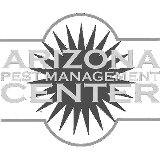The off-target movement of Dicamba and 2,4-D that was applied to resistant cotton and soybeans in the Midwest and south has been in the news for the last few years. It has exploded recently with the cancellation of these uses by a Federal court and the EPA. There have
not been serious problems with these herbicides here in Arizona. The focus of this article is to explain why not.
The Problem
Much of the cotton, corn and soybeans grown in the U.S. was Glyphosate resistant for several years. The number of Glyphosate resistant weeds have increased every year and new concerns about the effect of Glyphosate on human health and environmental safety have arisen. In response to this problem, new varieties of cotton, corn and soybeans have been developed that are resistant to a couple of old but highly effective herbicides, Dicamba and 2,4-D. These herbicides have high vapor pressures and can volatilize after application. They change from a liquid or solid to a gas after application and can move, sometimes long distances, in the air. Any herbicide can drift onto sensitive crops during application and cause injury. This is different than volatilization. New formulations of 2,4-D and Dicamba have been developed, however, that have significantly lower volatility. Studies have shown that while the potential is lower that it still can occur. Volatilization of both Dicamba and 2,4-D have caused widespread problems to field crops, trees, parks, school yards, landscapes… to cause “Silent Spring “type conditions in the Midwest and south. Volatility problems occasionally occur but widespread and serious problems have not been encountered in Arizona.
Environmental Conditions
The extreme conditions that exist during the summer in the low deserts of Arizona all contribute to herbicide volatility. High temperature, low humidity and the occurrence of temperature inversions have always made it difficult to use volatile herbicides here. Growers and Pest Control Advisers have learned to be cautious when using these products. They are rarely used after daytime temperatures go much above 90 degrees.
Acreage and Crop Diversity
Crops are grown in Arizona on a smaller scale and more intensively than they are in the Midwest and south. This is especially true in the southwestern counties. The acreage of cotton in 2019, for instance, was 173,000 acres in Arizona,4,350,000 in Texas,1,305,000 in Georgia,550,000 in Oklahoma and 497,000 in Alabama. This smaller scale allows Arizona growers to practice more careful management. Sprayers are cleaned more carefully or dedicated to spraying only volatile products. Fields and surrounding area are checked more frequently. In high acreage states, tens of thousands of acres can be treated at the same time with the same products. The amount of herbicide in the environment at those times is very high. In Arizona not only are crops grown on a smaller scale, but they are more diversified. It is not uncommon to see 3 ,4 or more different crops being grown at the same time on a 20 acre block. When fields are sprayed it is done very carefully.
Newer formulations and Varieties
New formulations of both Dicamba and 2,4-D have been developed that are much less volatile than the old formulations. Although some of these are promoted as non-volatile, they can still move. Some studies have shown that they are 30 to 50% more stable. It will be variable and dependent on many factors. It is important to choose those cotton varieties that have been developed to tolerate Dicamba or 2,4-D. According to Randy Norton, U of Az. Cotton Specialist, upwards of 60% of the cotton varieties being grown in Arizona this year are Dicamba resistant. Randy states that these varieties were selected for their yield and lint quality more so than their resistance to Dicamba.





